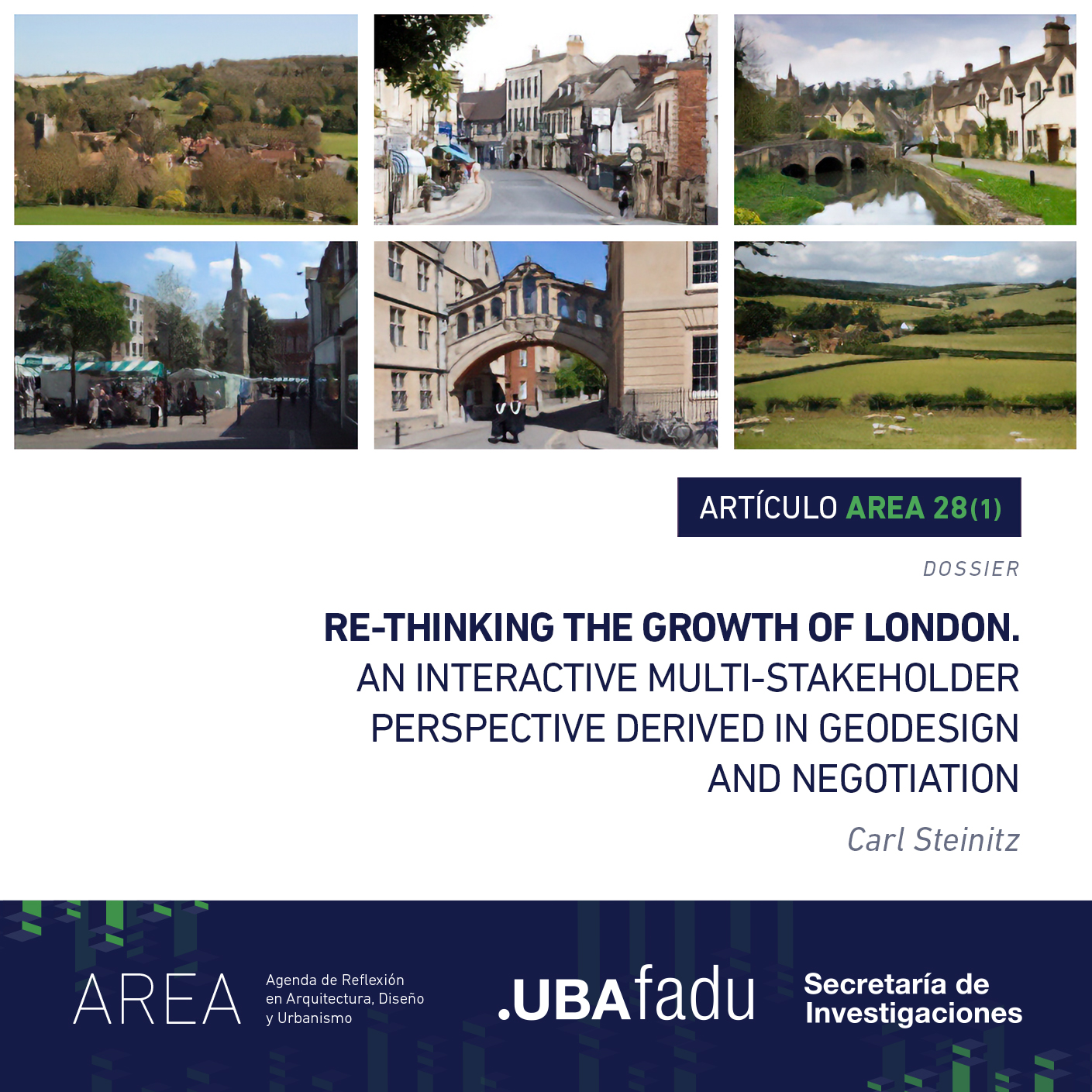Re-thinking the growth of London. An interactive multi-stakeholder perspective derived in geodesign and negotiation
Palabras clave:
Climate change, Demographic growth, Land use change, Stakeholder, Collaboration, Geodesign, Negotiation, Cambio climático, Crecimiento demográfico, Cambio de uso de suelo, Colaboración de las partes, Interesadas, Geodiseño, NegociaciónResumen
The Cambridge-Milton Keynes-Oxford (CAMKOX) Corridor is the fastest growing region in the United Kingdom. The UK National Infrastructure Commission proposes to add 780,000 housing units and 1,450,000 people to the existing CAMKOX population of around 3,300,000. However, it is highly likely that the conditions under which this objective would be met by 2050 will be substantially different from those of today. The direct and indirect impacts of projected climate change, demographic growth and technical innovation must be considered in relationship to current conditions. In this context, a two-day workshop was organized among interested stakeholders by the Centre for Advanced Spatial Analysis of University College London, with the participation of 20 professional planners and academics with CAMKOX experience. Geodesign modifies geography by design at intentional change. It tightly couples the creation of proposals for change with impact simulations informed by geographic contexts and systems thinking. Coming to a politically acceptable planning strategy inevitably implies negotiation among local people, aided by geographic scientists and design professionals, supported by information technologists. The digital tools to enable a collaboratively negotiated consensus are based on diagrams of policies and projects to produce an outcome only indicating that “It can be…or might be… something like this”. Participant teams each applied one of three scenarios of early, late, or non-adoption of systems policy and project innovations, reporting the designs and their impacts at three time-steps, 2020 (existing), 2035, and 2050. These were compared and negotiated to one final design.
Descargas
Citas
Ballal, H. (2015). Collaborative Planning with Digital Design Synthesis. [PhD Dissertation], London: Centre for Advanced Spatial Analysis, Faculty of the Built Environment, University College London.
Ballal, H. (s.f.). Geodesignhub. Recovered from https://www.geodesignhub.com/
Batty, M. (2013, February). Defining Geodesign (= GIS + Design?). Environment and Planning B: Planning and Design, 40(1), pp. 1–2.
Fisher, T. R. (2016, December), An Education in Geodesign. Landscape and Urban Planning, (156), pp. 20–22.
Fisher, T. R., Orland, B. & Steinitz, C. (2020), The International Geodesign Collaboration. Redlands: Esri Press.
Goodchild, M. F. (2010). Towards geodesign: Repurposing cartography and GIS? Cartographic Perspectives, (66), pp. 7–22.
Hollstein, L. M. (2019, June). Retrospective and reconsideration: The first 25 years of the Steinitz framework for landscape architecture education and environmental design. Landscape and Urban Planning, (186), pp. 56–66.
International Geodesign Collaboration-IGC. (n.d.). Changing Geography by Design. [Online]. Recovered from https://www.igc-geodesign.org/
Malcolm Reading Co. (s.f.). Short list. [Online]. Recovered from https://competitions.malcolmreading.com/cambridgeoxfordconnection/shortlist
Neuman, M., Tchapi, M., Sharkey, M., Gelgota, A, Itova, I. (2018), East West Arc: Re-thinking Growth in the London Region, University of Westminster, London.
Orland, B., and Steinitz, C. (2019), Improving our Global Infrastructure: The International Geodesign Collaboration, in Journal of Digital Landscape Architecture, 4-2019, Wichmann, pp 213–221.
Pettit, C. P., Hawken, S., Ticzon, C., Steinitz, C., Ballal, H., Canfield. T., Leal, S. Z., Lieske. S. N. & Afrooz, A. E. (2019, October). Breaking down the silos through geodesign – Envisioning Sydney’s urban future. Environment and Planning B: Urban Analytics and City Science, 46(8), pp 1–18.
Rivero, R., Smith, A., Ballal, H., and Steinitz, C. (2015), Promoting Collaborative Geodesign in a Multidisciplinary and Multiscale Environment: Coastal Georgia 2050, USA, Buhmann, E., Ervin, S., and Pietsch, P., (Eds) Digital Landscape Architecture 2015, Herbert Wichmann Press, Germany, pp. 42–58.
Rowe, P. G. (2017). Design thinking in the digital age. Cambridge/Berlin: Harvard University Graduate School of Design/Sternberg Press.
Rowe, P. G. (1987). Design thinking, Cambridge: The MIT Press.
Simon, H. (1996). The Sciences of the Artificial. Cambridge: The MIT Press.
Steinitz, C. (2017, 10 de octubre). A Digital Workflow for Dynamic Geodesign. [Video file]. Esri Events. Recuperado de https://youtu.be/QERJbL9J1Xw
Steinitz, C. (2012). A Framework for Geodesign. Redlands: Esri Press.
Steinitz, C. (1990). A Framework for Theory Applicable to the Education of Landscape Architects (and other Environmental Design Professionals). Landscape Journal, 9(2), pp. 136–143.

Descargas
Publicado
Cómo citar
Número
Sección
Licencia

© 1992-2025 – Revista AREA, su sitio, contenidos y metadata están bajo licencia de Acceso Abierto CC BY-NC-ND 2.5 AR







